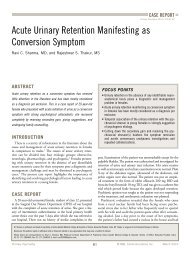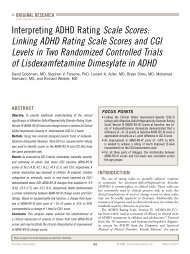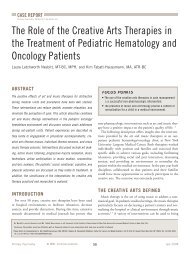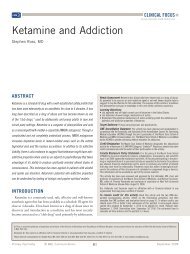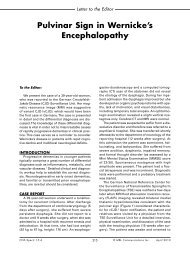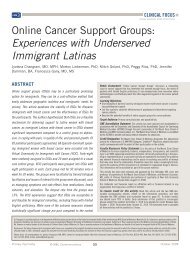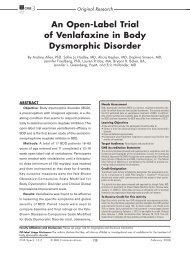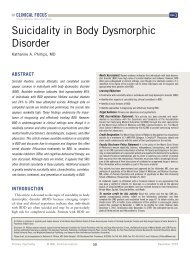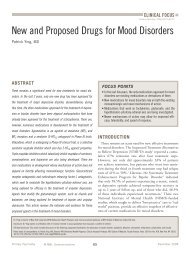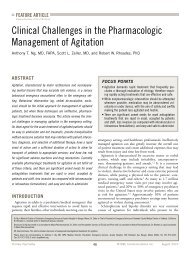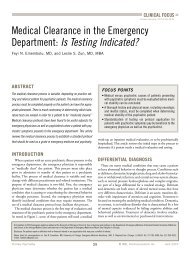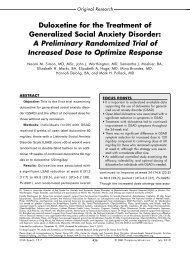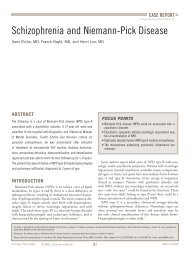Comparative Efficacy and Safety of Lisdexamfetamine Dimesylate ...
Comparative Efficacy and Safety of Lisdexamfetamine Dimesylate ...
Comparative Efficacy and Safety of Lisdexamfetamine Dimesylate ...
Create successful ePaper yourself
Turn your PDF publications into a flip-book with our unique Google optimized e-Paper software.
R. Lasser, B. Dirks, B. Adeyi, T. Babcock<br />
subjects had a mean (SD) SBP increase from baseline at endpoint<br />
<strong>of</strong> 0.7 (9.2) mm Hg. At endpoint, subjects treated with<br />
MAS XR demonstrated a mean (SD) change in SBP from<br />
baseline <strong>of</strong> 2.1 (12.9) mm Hg. The maximum mean (SD)<br />
changes from baseline in SBP for the active treatment<br />
groups occurred at week 3 for LDX (1.5 [9.7] mm Hg)<br />
<strong>and</strong> at week 4 for MAS XR (2.2 [13.1] mm Hg). In their<br />
respective trials, both LDX <strong>and</strong> MAS XR were also associated<br />
with small mean increases from baseline in DBP at<br />
endpoint (Table 5). At endpoint, subjects treated with LDX<br />
exhibited a mean (SD) increase in DBP <strong>of</strong> 1.3 (7.5) mm<br />
Hg compared with 3.6 (9.9) mm Hg exhibited by MAS<br />
XR-treated subjects. The maximum mean (SD) change from<br />
baseline in DBP occurred at week 2 for LDX-treated subjects<br />
(1.9 [7.0] mm Hg) <strong>and</strong> at week 4 for MAS XR-treated<br />
subjects (3.6 [10.0] mm Hg). The lower dose <strong>of</strong> LDX (ie,<br />
50 mg) was actually associated with a mean (SD) 0.3 (9.1) mm<br />
Hg decrease in SBP, while both doses <strong>of</strong> MAS XR were associated<br />
with increases in SBP at endpoint. Similarly, while both<br />
stimulants resulted in minimal increases in DBP at endpoint,<br />
the mean (SD) elevations associated with 70 mg/day LDX were<br />
~2.5 times less than observed in subjects receiving 40 mg/day<br />
MAS XR (1.7 [6.9] mm Hg versus 4.3 [8.7] mm Hg).<br />
In both trials, stimulant treatment was associated with mean<br />
increases in pulse (Table 5). The placebo-treated cohorts demonstrated<br />
virtually no mean (SD) change in pulse from baseline at<br />
TABLE 4<br />
endpoint: 0 (9.2) beats per minute (bpm) <strong>and</strong> 0.4 (11.3) bpm<br />
for placebo cohorts in the LDX <strong>and</strong> MAS XR trials, respectively.<br />
At endpoint, LDX <strong>and</strong> MAS XR were associated with mean<br />
(SD) increases in pulse <strong>of</strong> 4.6 (10.7) bpm <strong>and</strong> 4.9 (11.4) bpm,<br />
respectively. For the combined active treatment groups, the<br />
maximal mean (SD) increases in pulse were observed at week 3:<br />
5.7 (10.4) bpm for LDX <strong>and</strong> 6.0 (13.5) bpm for MAS XR.<br />
Overall, participants rarely met outlier criteria (Table 6).<br />
Blood pressure (BP) outlier criteria were not met at endpoint<br />
by any subject receiving LDX. Moreover, no subject in the<br />
present analysis had a QT or QTcF interval >480 msec at<br />
any LDX or MAS XR treatment week, nor did any subject<br />
demonstrate a prolongation <strong>of</strong> QTcF <strong>of</strong> 60 msec or more from<br />
baseline at any study week.<br />
Consistent with the short-term safety pr<strong>of</strong>ile <strong>of</strong> stimulants,<br />
in the present analysis both LDX <strong>and</strong> MAS XR were associated<br />
with dose-dependent decreases in weight. In the LDX trial,<br />
subjects receiving placebo exhibited a mean (SD) increase in<br />
weight from baseline <strong>of</strong> 0.4 (2.9) lb at endpoint. In contrast,<br />
subjects receiving 50 <strong>and</strong> 70 mg LDX exhibited mean (SD)<br />
changes in weight <strong>of</strong> -3.1 (6.5) lb <strong>and</strong> -4.3 (4.5) lb, respectively.<br />
At endpoint <strong>of</strong> the MAS XR trial, the mean (SD) change in<br />
weight from baseline was -2.1 (4.0) lb <strong>and</strong> -6.4 (4.9) lb in the<br />
20 <strong>and</strong> 40 mg/day dose groups, respectively, compared with<br />
0.4 (4.9) lb increase in the placebo group.<br />
TEAES REPORTED DURING MAS XR TRIAL BY ≥5% OF SUBJECTS IN EITHER MAS XR TREATMENT GROUP<br />
Body System Preferred Term<br />
(MedDRA 9.1)<br />
MAS XR 20 mg/day<br />
(n=41) n (%)<br />
MAS XR 40 mg/day<br />
(n=42) n (%)<br />
All MAS XR Doses<br />
(n=83) n (%)<br />
Placebo<br />
(n=45) n (%)<br />
Difference in % Incidence <strong>of</strong> All<br />
MAS XR Doses Minus Placebo (%)<br />
Any TEAE 32 (78.0) 35 (83.3) 67 (80.7) 24 (53.3) 27.4<br />
Agitation 3 (7.3) 2 (4.8) 5 (6.0) 1 (2.2) 3.8<br />
Anorexia 0 3 (7.1) 3 (3.6) 0 3.6<br />
Anxiety 4 (9.8) 2 (4.8) 6 (7.2) 3 (6.7) 0.5<br />
Decreased appetite 9 (22.0) 13 (31.0) 22 (26.5) 1 (2.2) 24.3<br />
Diarrhea 3 (7.3) 3 (7.1) 6 (7.2) 0 7.2<br />
Dizziness 2 (4.9) 3 (7.1) 5 (6.0) 0 6.0<br />
Dry mouth 10 (24.4) 18 (42.9) 28 (33.7) 3 (6.7) 27.0<br />
Fatigue 2 (4.9) 3 (7.1) 5 (6.0) 3 (6.7) -0.7<br />
Headache 7 (17.1) 10 (23.8) 17 (20.5) 3 (6.7) 13.8<br />
Initial insomnia 3 (7.3) 2 (4.8) 5 (6.0) 0 6.0<br />
Insomnia 10 (24.4) 8 (19.0) 18 (21.7) 4 (8.9) 12.8<br />
Irritability 2 (4.9) 1 (2.4) 3 (3.6) 5 (11.1) -7.5<br />
Palpitation 4 (9.8) 1 (2.4) 5 (6.0) 0 6.0<br />
Weight loss 3 (7.3) 9 (21.4) 12 (14.5) 0 14.5<br />
TEAEs=treatment-emergent adverse events; MAS XR=mixed amphetamine salts extended release; MedDRA=Medical Dictionary for Regulatory Activities.<br />
Lasser R, Dirks B, Adeyi B, Babcock T. Primary Psychiatry. Vol 17, No 9. 2010.<br />
Primary Psychiatry 50<br />
© MBL Communications Inc. September 2010



